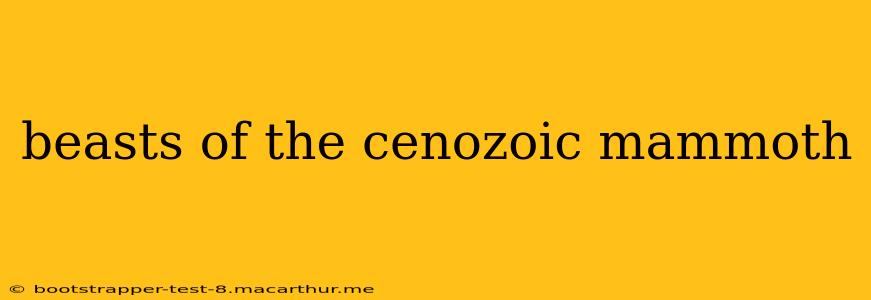The Cenozoic Era, spanning from 66 million years ago to the present, witnessed an incredible diversification of life, particularly among mammals. Among the most iconic and fascinating megafauna of this era is the mammoth, a truly colossal creature that roamed the globe for millions of years. This article delves into the world of mammoths, placing them within the broader context of the diverse Cenozoic ecosystem and addressing some frequently asked questions.
What is the Cenozoic Era?
The Cenozoic Era, often called the "Age of Mammals," follows the Cretaceous–Paleogene extinction event that wiped out the non-avian dinosaurs. This period saw the rise and diversification of mammals, birds, and flowering plants, shaping the landscapes and ecosystems we recognize today. Mammoths, along with many other impressive creatures, thrived during various epochs within the Cenozoic, contributing significantly to the era's biodiversity.
What Makes Mammoths so Special?
Mammoths belonged to the genus Mammuthus, a group of proboscideans closely related to modern elephants. These impressive creatures were characterized by their massive size, long curved tusks, and in many species, a thick coat of fur that helped them survive in cold climates. The most famous species, the woolly mammoth (Mammuthus primigenius), adapted remarkably well to the icy landscapes of the Pleistocene epoch. Their adaptations included:
- Thick fur: Provided excellent insulation against frigid temperatures.
- Small ears: Reduced heat loss.
- Large body size: Helped retain heat more efficiently (Bergmann's rule).
- High-fat diet: Provided energy for survival in harsh conditions.
What Other Megafauna Lived Alongside Mammoths?
The Cenozoic wasn't just about mammoths; a rich tapestry of other incredible creatures shared the planet. During the Pleistocene epoch, alongside mammoths, we find creatures like:
- Saber-toothed cats: Predatory mammals with elongated canines.
- Giant ground sloths: Massive herbivores with long claws.
- Cave bears: Large bears adapted to cave dwelling.
- Mastodons: Another type of proboscidean, though differing in tusk structure and overall morphology from mammoths.
- Giant deer (Megaloceros): Possessed enormous antlers.
These animals, along with many others, formed intricate food webs and ecological relationships, significantly impacting the landscapes they inhabited. The extinction of many of these megafauna at the end of the Pleistocene remains a subject of ongoing scientific investigation.
When Did Mammoths Go Extinct?
The extinction of mammoths wasn't a single event. Woolly mammoths persisted on Wrangel Island until approximately 4,000 years ago, making them one of the last surviving mammoth populations. Other mammoth species went extinct earlier, reflecting the complex interplay of environmental changes and human impact. The exact causes of their demise are still debated, with factors like climate change and human hunting likely playing significant roles.
What is the Difference Between Mammoths and Mastodons?
While both mammoths and mastodons were proboscideans, they differed in several key features:
- Tusks: Mammoths generally had longer, more curved tusks, whereas mastodons had straighter, more conical tusks.
- Teeth: Mammoths possessed high-crowned molars adapted for grazing, while mastodons had lower-crowned molars suitable for browsing.
- Body size and shape: While both were large, subtle differences existed in their body proportions.
These differences reflect distinct adaptations to different habitats and diets.
Were Mammoths related to Elephants?
Yes, mammoths are closely related to modern elephants. Both belong to the order Proboscidea, sharing a common ancestor. The close relationship is evident in their skeletal structure, genetic makeup, and overall morphology. Elephants are considered the closest living relatives to mammoths.
How Do We Know About Mammoths?
Our understanding of mammoths comes from a variety of sources:
- Fossil remains: Skeletal remains, teeth, and other fossilized materials provide detailed information about their anatomy and morphology.
- Frozen carcasses: Remarkably preserved mammoth carcasses found in permafrost have yielded valuable insights into their soft tissues, fur, and even stomach contents.
- Ancient art: Cave paintings and other forms of prehistoric art depict mammoths, providing clues about their appearance and the interactions humans had with them.
- Genetic analysis: DNA extracted from preserved remains allows for comparisons with modern elephants and provides valuable data on mammoth evolution and population dynamics.
The study of mammoths continues to evolve, with new discoveries constantly adding to our knowledge of these magnificent creatures and their place within the fascinating Cenozoic world.
